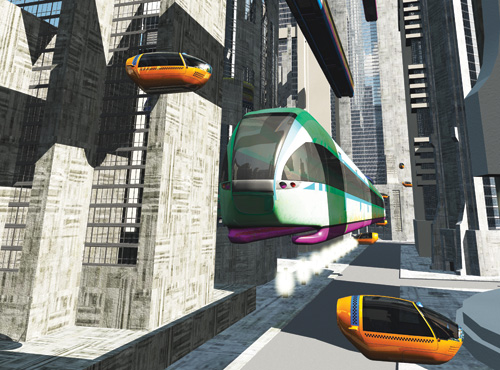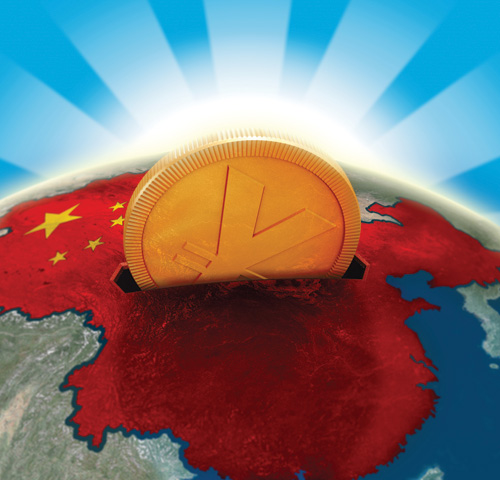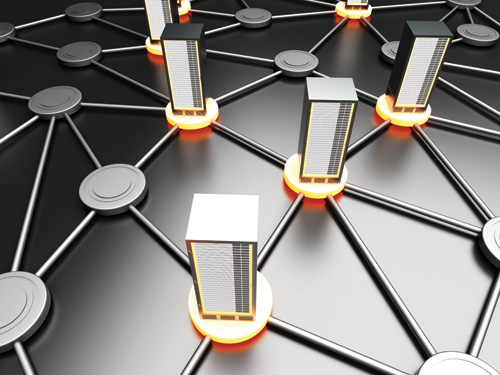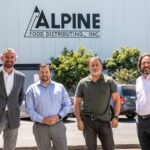 Rapid technological change, natural resource depletion and economic crisis transform the world as we know it.
Rapid technological change, natural resource depletion and economic crisis transform the world as we know it.
BY LINDA BAKER
 On a dark and stormy night, Sridhar Solur, director of mobility and cloud services at Hewlett-Packard, is in the Portland offices of software firm New Relic, weighing in on a subject close to his heart. “It’s about the future,” the dapper, jeans-clad Solur tells the audience, most of whom look like the kind of people Dave Chen, a principal at Equilibrium Capital, was describing to me a few days earlier as stereotypical 21st-century “disruptors”: “Guys who wear hats and have dogs underneath their desks.”
On a dark and stormy night, Sridhar Solur, director of mobility and cloud services at Hewlett-Packard, is in the Portland offices of software firm New Relic, weighing in on a subject close to his heart. “It’s about the future,” the dapper, jeans-clad Solur tells the audience, most of whom look like the kind of people Dave Chen, a principal at Equilibrium Capital, was describing to me a few days earlier as stereotypical 21st-century “disruptors”: “Guys who wear hats and have dogs underneath their desks.”
About 370,000 babies are born every day, observes Solur, whose talk, held in November, was the first in a monthly “FutureTalk” series co-sponsored by the Portland Incubator Experiment. Three billion people live in poverty, and about 2 million mobile devices are activated daily.
What’s Solur’s point? Mobile technology has “rewritten” Alexander Maslow’s famous hierarchy of needs; mobile phones, he observes wryly, have joined food, safety and shelter as essential to human existence. “Tell me one technology that has penetrated everyone’s life like mobile,” he says.
The New Relic audience is silent.
We live in a world where every aspect of human endeavor — science, business, education — is seemingly being overtaken by the tech sector. Or, as New Yorker writer Nathan Heller observed in a recent article about the social changes roiling San Francisco: “At some point, tech stopped being an industry and turned into the substrate of most things changing in urban culture.” But in a time where technological innovation is a constant, there are other major disruptions on the horizon: global warming, economic crisis and radical geo-demographic shifts — namely, the rise of China as a consumer culture.
To usher in the New Year, I asked a few executives in the business, policy and nonprofit sectors to opine on disruption in 2014: What are the game-changing forces (good and bad) shaping different industries? How are businesses and consumers reacting? And what is at stake for the way Oregonians live, work and play? The responses provide a snapshot of social, economic and environmental transformation, loosely framed around a common theme — a theme Solur sounded at the end of his talk. “To survive,” says this mobile futurist employed by an “incumbent” PC company, “every industry will have to transform.”
China and climate change
 |
By 2020 there will be about 21 million affluent households in China, representing 60 million consumers.Source: McKinsey & Company |
Amanda Oborne is having trouble sleeping at night. The director of food and farm programs at Ecotrust traces the source of her insomnia to two pending global cataclysms. The first is the roughly 3 billion middle-class Chinese consumers expected to come online in the next 15 years. “We have no concept of how much is going to change when the giant sucking sound coming out of Asia kicks into full gear,” Oborne says.
Ten years ago, China’s building boom led to massive fuel shortages worldwide; next it will be wine, meat and all the other middle-class amenities Americans take for granted. Oborne points to two major developments already reshaping global food production: This past fall, a Chinese company bought Smithfield, the biggest pork producer in the U.S., and legislation now allows companies to ship live chickens from the U.S. to China for processing and then back again. “That’s the first step in a domino effect that will lead Tyson to source chicken from China,” Oborne warns. “And we should be really nervous about that because of food-safety issues.”
Climate change is the other global disturbance contributing to Oborne’s “ambient stress levels”: “I joke all the time that Portland is going to be the next San Francisco because our weather is going to be such bliss as climate change takes effect,” she says. Oborne cites a recent University of Hawaii study identifying the date select cities will become uninhabitable because they will be too hot. Doomsday for Los Angeles is 2048; Houston, 2050.
“But the reality is that climate change is not just a matter of an influx of population from California,” Oborne says. “As people get hungry or run out of water, political unrest and violence will escalate.”
From the perspective of many Oregon food processors, skyrocketing Asian demand — and, perhaps, a more propitious growing season — is a positive, Oborne acknowledges. “If you ask Nancy’s Yogurt, Stahlbush Farms — those are great producers whose markets are going to explode.” But 85% of Oregon agriculture is already exported. To protect Oregonians against a “category 5 hurricane, global trade or political meltdown,” Ecotrust aims to carve out a locally owned and “high-functioning” processing and distribution infrastructure, Oborne says. That effort moves beyond farmers markets to encompass “a regional food system strong enough to be resilient regardless of what’s coming down the pike.”
“And what’s coming down the pike is enormous.”
Onshoring and the maker movement
 |
In 2013, 4 zettabytes of data, the equivalent of 250 billion DVDs, will be created, stored and replicated. By 2020, that amount it predicted to reach 40 zettabytes.Source: IDC Research |
Chris Scherer isn’t quite as apocalyptic as Oborne. But the president of the Oregon Manufacturing Extension Partnership, a nonprofit that helps manufacturers adapt to the challenges of a global economy, is plenty attuned to the winds of change. One major transformation under way is onshoring, Scherer says, a movement fueled by rising labor costs in Asia and Mexico, along with new lower-cost information management technologies such as “big data” and cloud computing. “The result is more companies are successful in reducing the hassles of doing [manufacturing] here.”
Undermining the onshoring trend is “the most disruptive force in the workplace today”: the depletion of human capital. The percentage of skilled workers 50 and older is “really high,” Scherer says. And as those people phase out, it’s increasingly difficult to replace them. To help recruit the next generation, manufacturers should pay attention to the tech sector, an industry that knows what millennials want. “The things software companies do to attract young workers are completely different than manufacturing,” Scherer says: “free gym membership, flex time.”
Over the next decade, “the changes manufacturers are going to have to adopt are pretty extreme,” he adds. But the industry tends to be “somewhat myopic” in terms of looking into the future. “That could create a situation where local companies are behind. Certainly in the workforce that is true; in technology, it could be true.”
If some manufacturers turn inward, plenty are eager to embrace forces of change. One is former Wired editor Chris Anderson, now CEO of 3D Robotics, who delivered the keynote speech at Greater Portland Inc.’s sixth annual economic summit this past fall. The speech, about technologies poised to “revolutionize” the manufacturing space — the 3-D printer, for example — hit home for Greater Portland Inc. president and CEO Sean Robbins, a man who spends a lot of his time thinking about the next phase of economic growth.
In Portland, “hackerspaces” such as Flux, BrainSilo and ADX already feature guilds of producers manufacturing “real products, real things,” Robbins says. As software and hardware costs continue to decline, the 3-D printer will only accelerate the “makers’ movement,” he says.
Indeed, a study conducted this year by Michigan Technological University considered 20 household items — smartphone cases, a garlic press — then calculated how much it would cost to make each using a household 3-D printer. The results are telling: It would cost between $312 and $1,944 to buy the items, but just $18 to make them using the 3-D printer. “It’s democratizing manufacturing,” Robbins says.
The convergence of software and internet connectivity, along with big data, also has the potential to unlock public institutions, he adds. Robbins cites as an example New York City’s “geek squad,” a city department that crunches all sorts of data — number of street trees, grease-disposal permits, 911 calls — to solve problems ranging from identifying violators of city codes to accelerating disaster cleanup. The larger goal is to leverage massive amounts of data to collaborate with citizens and create efficiencies between government agencies. “A smart city can transform public institutions over time,” Robbins says. “There is potential for huge civic disruption.”
The sharing economy
 |
An “aquapocalypse” – extreme flooding, drought and groundwater depletion – is “all but certain” to hit the U.S. in the next few decades.Source: UC Center for Hydrologic Modeling |
Robbins, Scherer, Oborne and Solur work in completely different industries. But there are several threads connecting their thinking about the future. First, an array of new technologies — and generational changes — are deconstructing formerly top-down organizations and companies. Along with global environmental and economic transformation, mobile devices and social-networking platforms are also catalyzing innovative business models organized around connection and convergence.
“Most of us here are digital immigrants: people born before computers,” says Solur, speaking to the New Relic crowd. “Our kids are digital natives.”
Solur references a TED Talk claiming the Earth’s carrying capacity will top off at 10 billion people. “We are moving toward a world where sharing of resources is absolutely necessary.” To store data, companies used to purchase large servers; today, they can lease processing power with Amazon. Instead of checking into hotels, a growing number of travelers use Airbnb to rent owner-occupied rooms.
“We are moving,” Solur says, “into an economy of digital hippies.”
On a rainy Friday morning, I met with Steve Gutmann, an entrepreneur who fits easily into the digital flower child category. The former head of business development at Getaround, the peer-to-peer car-sharing outfit, Gutmann recently launched Red Truck, an e-commerce startup. He also rents out his driveway, currently to a New York transplant who doesn’t want to pay for parking in the Pearl District.
“Innovation happens when there is technological change and accelerates when there is economic disruption,” Guttman tells me. “People are looking for new ways to make money, and everybody becomes an entrepreneur.” Gutmann admits to having a short attention span. “My wife rolls her eyes: ‘Honey, you’re always off to something new.’ But to me it’s clear that business as usual is 90 miles an hour down a dead-end street. Why would I want to get a job doing something that is not disruptive? Then you’re on the Titanic.”
It’s an apt metaphor for a transportation guru. Rising gas costs, bike commuting and declining numbers of teens getting driver’s licenses are already changing the urban-transport game. The next stage, says Gutmann, is the merging of car sharing with driverless technology, pioneered by Google and expected to show up on city streets in the next five years.
People tend to think of driverless technology as an add-on to personal cars, Guttman says. But what’s more likely is that city dwellers will view this technology as a service, like calling for a taxi. Gutmann predicts that car sharing company Car2Go, for example, will eventually offer the door-to-door mobility of driverless car travel.
“Instead of walking down the street to get a Car2Go, you’re just going to call it,” Gutmann says. He leans across the table, eyes sparkling. “Here’s the really disruptive part of it: Your kids will be able to take it.”
Cool, crappy or of-the-earth
Driverless cars, 3-D printers, government geek squads — it all smacks of cool sci-fi futurism. And yet the game-changing nature of today’s innovations is not always easy to discern. Many disruptive products or companies rarely impress on first glance, agrees Thomas Thurston. Another man of his times, Thurston is CEO of Growth Science, a firm that deploys big data-driven algorithms to predict the success of a given innovation.
“Look at Urban Airship,” he says, referring to Portland’s wunderkind push-button startup. “It’s all dressed up in sex appeal, but push-button is a cheap and crappy way to get ads. I admiringly say ‘cheap and crappy.’ Those are the ones that expand and take over the market.” With a post-IPO value of $29 million, Twitter is another example. “Talk about lame — 140 character notes. It’s not even email.”
Tech innovations today are notable for infiltrating companies outside the technology space, Thurston and others argue. With its startup incubator and FuelBand technology, for example, Nike is no longer a shoe company but a “digital sport company integrating software and hardware into product development,” observes Greater Portland Inc’s Robbins. Understanding this new business model will be key to capturing future job growth, he says.
The next tech tsunami, the “Internet of things,” will continue the flattening of the world. By 2016, people will be surrounded by thousands of sensors embedded in everyday objects — think wearable computing, smart cars, connected homes. Networked objects will change lives and drive a $30 billion market that so far lacks a dominant player, Solur observes. “Intel and Microsoft ruled the world of PCs; ARM-based processors with OIS and Android are dominating mobile.” But there is no operating system leader in the wearables space.
Solur peers at the New Relic audience. “The little money you have kept aside — you know what to do with it.”
Talk to enough people about disruption circa 2014 and a pattern amid the chaos emerges: New technologies are liquifying industry and government, opening up new business opportunities. Simultaneously, skyrocketing global demand for food, water and energy is putting a premium on decidedly old-fashioned assets. “They are not making farmland anymore,” Equilibrium Capital’s Dave Chen tells me. “So he who owns farmland will have a very good asset for a long period of time.”
Chen says the most interesting disruptions occurring today are occurring in the “rerouting of value flows” in the natural resource and sustainability sectors. He cites a landmark 10-year U.S. Forest Service contract signed last spring awarding hundreds of thousands of acres of restoration work in the Malheur National Forest. The contract, which enabled the Malheur Lumber Company, the last remaining mill in Grant County, to stay open, moves away from traditional timber contracts to place a monetary value on restoration, such as reducing wildfire threats and improving habitat — while also providing jobs.
Another example is a water-trading credit scheme championed by local environmental groups such as the Freshwater Trust, in which polluters buy and trade “credits” embodied in restoration projects instead of investing in higher-cost pollution control technologies. “It has the potential to rewrite how conservation is done in the waterways of the United States,” Chen says. “That’s not hyperbole.”
Without exception, everyone I interviewed for this story spoke in hyperbolic terms. It’s enough to make one play devil’s advocate. Do we really live in an age of disruption? After all, the history of the world is the history of disruption — and disruptive technology: the wheel, the railroad, the telephone. As for end-of-the-world rhetoric around depletion of resources, doesn’t every generation think of itself as the apocalyptic generation? When I was a child, I went to bed every night terrified of nuclear war. Imagine living in Japan, or Dresden, during WWII.
But if hyperbolic thinking is part of the human condition, every generation puts its own stamp on the process. And as we adapt to the next disruptive phase, three distinguishing characteristics are worth noting. First, the United States is no longer immune to the unpredictable and often destabilizing economic and environmental forces we are accustomed to observing in other parts of the world. Second, technology has accelerated incidences of disruption. And third, the tech entrepreneur is now considered the driver of both social and business model innovation. Perhaps more than government or the citizen activist, the startup has come to represent the change we want to see in the world.
Ours is an era in which everyone imagines herself a transformer — or feels the pressure to transform. This past October, Portland-based Mercy Corps hired Google’s former senior engineering director, Ann Mei Chang, for the newly created position of chief innovation officer. One of a small number of tech executives moving into the international aid arena, Chang embodies the cultural zeitgeist. “We’re interested,” she says, “in things that are game changing.”



